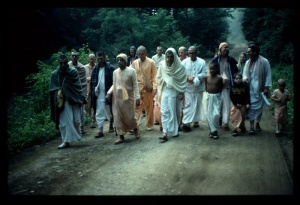CC Madhya 7.109 (1975)

A.C. Bhaktivedanta Swami Prabhupada
Below is the 1996 edition text, ready to be substituted with the 1975 one using the compile form.
TEXT 109
- navadvīpe yei śakti nā kailā prakāśe
- se śakti prakāśi’ nistārila dakṣiṇa-deśe
SYNONYMS
navadvīpe—at Navadvīpa; yei—that which; śakti—the potency; nā—not; kailā—did; prakāśe—manifestation; se—that; śakti—potency; prakāśi’—manifesting; nistārila—delivered; dakṣiṇa-deśe—South India.
TRANSLATION
Lord Śrī Caitanya Mahāprabhu did not manifest His spiritual potencies at Navadvīpa, but He did manifest them in South India and liberated all the people there.
PURPORT
At that time there were many smārtas (nondevotee followers of Vedic rituals) at the holy place of Navadvīpa, which was also the birthplace of Lord Śrī Caitanya Mahāprabhu. Followers of the smṛti-śāstra are called smārtas. Most of them are nondevotees, and their main business is following the brahminical principles strictly. However, they are not enlightened in devotional service. In Navadvīpa all the learned scholars are followers of the smṛti-śāstra, and Lord Caitanya Mahāprabhu did not attempt to convert them. Therefore the author has remarked that the spiritual potency Lord Śrī Caitanya Mahāprabhu did not manifest at Navadvīpa was by His grace manifested in South India. Thus everyone there became a Vaiṣṇava. By this it is to be understood that people are really interested in preaching in a favorable situation. If the candidates for conversion are too disturbing, a preacher may not attempt to spread Kṛṣṇa consciousness amongst them. It is better to go where the situation is more favorable. This Kṛṣṇa consciousness movement was first attempted in India, but the people of India, being absorbed in political thoughts, did not take to it. They were entranced by the political leaders. We preferred, therefore, to come to the West, following the order of our spiritual master, and by the grace of Lord Caitanya Mahāprabhu this movement is becoming successful.